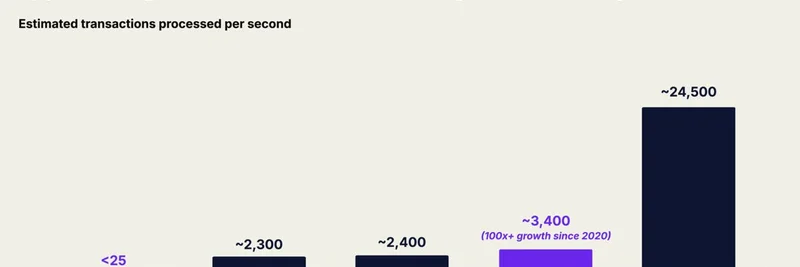Hey, crypto enthusiasts—if you've been riding the waves of meme tokens like PEPE or DOGE, you know speed matters. But imagine if the entire blockchain backbone could keep up with the frenzy without breaking a sweat. That's exactly what's happening right now, according to a eye-opening stat from a16z's State of Crypto report. In just five years, aggregate transaction throughput across major blockchain networks has skyrocketed more than 100x. We're talking from a sluggish under 25 transactions per second (TPS) in 2020 to a blistering 3,400 TPS today.
This isn't just tech jargon—throughput is basically how many transactions a network can handle every second without choking. Back in the early days, blockchains were like that one friend who shows up late to every party: full of potential but bogged down by bottlenecks. Now? They're matching the pace of some of the world's biggest financial heavyweights, all while slashing costs dramatically.
Breaking Down the Numbers: Blockchains vs. Traditional Finance
That chart you see above (shoutout to MartyParty for sharing it on X) lays it out crystal clear. Here's the quick rundown:
- Blockchain in 2020: Fewer than 25 TPS. Oof—barely enough to process a coffee run.
- Blockchain Today (2025): ~3,400 TPS, with over 100x growth. That's the kind of scaling that turns heads.
- Stripe on Black Friday/Cyber Monday: Around 2,300 TPS during peak shopping madness.
- Nasdaq Trades (Open Hours): Roughly 2,400 TPS on a typical trading day.
- Credit Card Transactions (2025 Projection): A whopping ~24,500 TPS, but that's the outlier here—blockchains are closing in fast.
Sources like a16z's own analysis, Stripe's 2024 data, and Nasdaq's September 2025 figures back this up. The kicker? Blockchains are doing all this at a fraction of the historical cost per transaction. No more sky-high gas fees crippling your meme coin flips.
Why This Matters for Meme Token Traders and DeFi Degens
If you're deep in the meme ecosystem—swapping SOL-based pups or ETH-flavored frogs—this throughput boom is your secret weapon. Faster networks mean less slippage during pumps, quicker executions for those viral token launches, and smoother experiences across DEXs like Uniswap or Raydium. Remember the 2021 gas wars? Yeah, those are fading into meme history.
It's not just about speed; it's about scalability unlocking real-world adoption. As blockchains hit Nasdaq-level efficiency, we're seeing more bridges to tradfi (traditional finance). Think: meme tokens powering micro-payments in games or social apps, without the lag that kills the vibe.
a16z calls this the "infrastructure renaissance," and they're spot on. With layer-2 solutions like Optimism and Arbitrum stacking on top, the growth trajectory points to even wilder numbers ahead. If 100x happened in five years, what's next—1,000x?
The Bigger Picture: From Hype to Hyper-Scale
MartyParty nailed it in his X post: This is "amazing work" from a16z, highlighting how crypto's plumbing has leveled up. For us at Meme Insider, it's a reminder that behind every moonshot meme is a robust chain ready to handle the heat.
Keep an eye on reports like this—they're gold for spotting the next big shift. Whether you're HODLing blue-chips or hunting alpha in under-the-radar tokens, understanding throughput is key to staying ahead.
What do you think—will blockchains outpace credit cards next? Drop your takes in the comments, and let's meme this evolution together. 🚀



